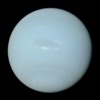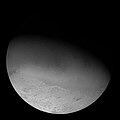Neptune Odyssey
 Artist's concept of a Neptune orbiter with potential atmospheric probes and a Triton lander, c. early 2000s | |
| Mission type | Neptune orbiter |
|---|---|
| Operator | NASA |
| Mission duration | Cruise: 16 years Science phase: 4 years[1] |
| Spacecraft properties | |
| Launch mass | 3,218 kg (7,094 lb)[1] |
| Dry mass | 1,594 kg (3,514 lb)[1] |
| Payload mass | 214 kg (472 lb) plus 220 kg (490 lb) atmospheric probe[1] |
| Dimensions | Height: 6.96 m (22.8 ft) Diameter: 4.56 m (15.0 ft)[1] |
| Power | 1,087 W (1.458 hp) from 3 Next-Generation Radioisotope thermoelectric generators[1] |
| Start of mission | |
| Launch date | 2033 (proposed)[1] |
| Rocket | Space Launch System (proposed) Falcon Heavy (alternative)[1] |
| Neptune orbiter | |
| Orbital insertion | 2049 (proposed)[1] |
| Neptune atmospheric probe | |
| Atmospheric entry | 2049 (proposed)[1] |
Neptune Odyssey is an orbiter mission concept to study Neptune and its moons, particularly Triton.[1] The orbiter would enter into a retrograde orbit of Neptune to facilitate simultaneous study of Triton and would launch an atmospheric probe to characterize Neptune's atmosphere. The concept is being developed as a potential large strategic science mission for NASA by a team led by the Applied Physics Laboratory at Johns Hopkins University. The current proposal targets a launch in 2033 using the Space Launch System with arrival at Neptune in 2049, although trajectories using gravity assists at Jupiter have also been considered with launch dates in 2031.
The mission concept was considered for possible recommendation as a mission priority in the 2023–2032 Planetary Science Decadal Survey. However, for logistical reasons the Uranus Orbiter and Probe mission was selected as the ice giant orbiter mission recommendation, with top priority ahead of the Enceladus Orbilander.[2][3]
Background
Voyager 2 is the only space probe to have visited the Neptune system, completing a flyby on August 25, 1989. An orbiter to Neptune was considered as part of the aborted Mariner Mark II program in the 1990s, and several mission concepts for an orbiter were developed in the 2000s, including a concept by the California Institute of Technology[4] and a version by the University of Idaho and Boeing,[5] though none were selected for further development. The 2011-2022 Planetary Science Decadal Survey recommended a Flagship-class orbiter mission to an ice giant with priority behind what would become the Mars 2020 rover and the Europa Clipper.[6] Ice giants are now appreciated as a common type of exoplanet, precipitating the need for further study of ice giants in the Solar System.[7] The ice giants Uranus and Neptune were seen as unique yet equally compelling scientific targets, but a Uranus Orbiter and Probe was given preference for logistical and cost reasons.[6][8] A Uranus orbiter would logically follow Flagship-class orbiter missions undertaken at Jupiter and Saturn (Galileo and Cassini, respectively). A mission to Neptune is viewed by some to be of greater scientific merit[9] because Triton, likely a captured Kuiper belt object and ocean world, is a more compelling astrobiology target than the moons of Uranus (though Ariel and Miranda in particular are possible ocean worlds).[10] Nevertheless, again due to cost and logistical considerations including launch vehicle availability and available launch windows, the 2023–2032 Planetary Science Decadal Survey recommended the Uranus Orbiter and Probe instead of Neptune Odyssey.[2][3] A less capable version of the Odyssey concept with more focus on Triton in lieu of ice giant science called Triton Ocean World Surveyor is being developed as a possible future New Frontiers mission.[2][11] Another Triton-focused Neptune orbiter proposal called Nautilus was developed by several graduate students at the Jet Propulsion Laboratory in summer 2023; under the New Frontiers program, it would be launched in August 2042 and arrive in orbit in April 2057.[12][13]

Two flyby mission proposals for Neptune and Triton also exist, both of which would conduct a flyby in 2038. The China National Space Administration's Interstellar Express, a trio of probes designed to explore the heliosphere, would have its second probe (IHP-2) explore Neptune and deliver an atmospheric probe before going off to explore a Kuiper Belt object and fly toward the tail of the heliosphere. NASA's Trident was a finalist for selection as a Discovery mission in 2020, with a proposed launch in 2025 and an intent to focus on Triton.[14] In June 2021, it was announced that Trident was not selected for development and launch,[15] while Interstellar Express is yet to be approved by CNSA.
Objectives

There are five primary scientific questions to be addressed by an orbiter at Neptune:[1]
- How do the interiors and atmospheres of ice giant [exo]planets form and evolve?
- What causes Neptune's strange magnetic field, and how do its magnetosphere and aurorae work?
- Is Triton an ocean world? What causes its plumes? What is the nature of its atmosphere?
- How can Triton's geophysics and composition expand our knowledge of dwarf planets like Pluto?
- What are the connections between Neptune's rings, arcs, surface weathering, and small moons?
Mission concept

The present proposal targets a launch in 2033 using the Space Launch System and a 16-year cruise directly to Neptune, with launch windows yearly during the 2030s. The cruise could be shortened to 12 years with a gravity assist at Jupiter, but this would require launch prior to 2032. A 220 kg (490 lb) atmospheric probe will be released from the orbiter before orbital insertion at Neptune and descend for around 37 minutes into Neptune's atmosphere to study its composition, dynamics, and processes, sending data at least until reaching a pressure of 10 bars. After achieving Neptune orbit, the orbiter will conduct at least 46 flybys of Triton over the four-year main science phase, achieving near-global coverage of the moon while simultaneously studying Neptune and other moons. The orbiter would then orbit progressively closer to Neptune and its rings on a "Grand Finale" similar to the Grand Finale of Cassini and eventually be destroyed in Neptune's atmosphere for planetary protection purposes.
The current proposal does not include a Triton lander. Both a static lander similar to the Huygens probe to Titan and an impactor that would release surface material for direct study by the orbiter were considered.[1] Ultimately, due to the incomplete knowledge of Triton's surface, risk of the close approach to Triton that an impactor would require, and priority of the atmospheric probe with respect to payload limitations, a lander is not presently part of the mission concept.
Orbiter instruments
The orbiter is proposed to carry 14 scientific instruments.[1]
| Instrument | Heritage Instrument | Heritage Mission |
|---|---|---|
| Magnetometer | MESSENGER Magnetometer | MESSENGER |
| Color Narrow-Angle Camera | Long Range Reconnaissance Imager (LORRI) | New Horizons |
| Ultraviolet Imaging Spectrograph | Alice | New Horizons |
| Ion and Neutral Mass Spectrometer | Ion and Neutral Mass Spectrometer | Cassini |
| Laser Altimeter | Mercury Laser Altimeter | MESSENGER |
| Visible-Near Infrared Imaging Spectrometer | Ralph | New Horizons |
| Radio and Plasma Wave Detector | Waves | Juno |
| Thermal Infrared Imager | Diviner | Lunar Reconnaissance Orbiter |
| Microwave Radiometer | Microwave Radiometer | Juno |
| Thermal Plasma Spectrometer | Jovian Auroral Distributions Experiment (JADE) | Juno |
| Energetic Charged Particle Detector | EPI-Lo | Parker Solar Probe |
| Energetic Neutral Atom Imager | IMAP-Ultra | Interstellar Mapping and Acceleration Probe |
| Dust Detector | Interstellar Dust Experiment (IDEX) | Interstellar Mapping and Acceleration Probe |
| Public Engagement Camera (visible) | Comet Infrared and Visible Analyser (CIVA) | Rosetta |
Atmospheric probe instruments
The atmospheric probe is proposed to carry 8 scientific instruments.[1]
| Instrument | Heritage Instrument | Heritage Mission |
|---|---|---|
| Mass Spectrometer | Huygens mass spectrometer | Huygens |
| Atmospheric Structure Instrument | Huygens Atmospheric Structure Instrument (HASI) | Huygens |
| Helium Abundance Detector | Galileo probe Helium Abundance Detector | Galileo |
| Ortho-Para H2 Detector | (in development)[7] | none |
| Nephelometer | Galileo probe Nephelometer | Galileo |
| Net Flux Radiometer | Galileo probe net-flux radiometer | Galileo |
| Doppler Wind Experiment | Huygens Doppler Wind Experiment (DWE) | Huygens |
| Public Engagement Camera | Philae camera | Philae |
References
- ^ a b c d e f g h i j k l m n o Abigail Rymer; Brenda Clyde; Kirby Runyon (August 2020). "Neptune Odyssey: Mission to the Neptune-Triton System" (PDF). Retrieved 18 April 2021.
- ^ a b c Origins, Worlds, and Life: A Decadal Strategy for Planetary Science and Astrobiology 2023-2032 (Prepublication ed.). National Academies Press. 19 January 2023. p. 800. doi:10.17226/26522. ISBN 978-0-309-47578-5. S2CID 248283239. Retrieved 30 April 2022.
- ^ a b Foust, Jeff (19 April 2022). "Planetary science decadal endorses Mars sample return, outer planets missions". SpaceNews. Retrieved 19 April 2022.
- ^ Douglas Fiehler and Steven Oleson. (July 2004). "Neptune Orbiters Utilizing Solar and Radioisotope Electric Propulsion". 40th AIAA/ASME/SAE/ASEE Joint Propulsion Conference and Exhibit. American Institute of Aeronautics and Astronautics. doi:10.2514/6.2004-3978. hdl:2060/20040139505. ISBN 978-1-62410-037-6. S2CID 110384884. Retrieved 3 September 2016.
- ^ Bernie Bienstock and David Atkinson (10 June 2005). "NEPtune Orbiter with Probes" (PDF). Outer Planets Assessment Group. Retrieved 3 September 2016.
- ^ a b "Visions and Voyages for Planetary Science in the Decade 2013–2022". Retrieved 20 April 2021.
- ^ a b "Ice Giants Pre-Decadal Survey Mission Report". Retrieved 20 April 2021.
- ^ Hubbard, William B. (3 June 2010). "SDO-12345: Ice Giants Decadal Study" (PDF). National Academies Press. National Academy of Sciences. Archived (PDF) from the original on 6 May 2021. Retrieved 22 June 2020.
- ^ Moore, Jeff; Spilker, Linda; Bowman, Jeff; Cable, Morgan; Edgington, Scott; Hendrix, Amanda; Hofstadter, Mark; Hurford, Terry; Mandt, Kathleen; McEwen, Alfred; Paty, Carol; Quick, Lynnae; Rymer, Abigail; Sayanagi, Kunio; Schmidt, Britney; Spilker, Thomas (2021). "Exploration Strategy for the Outer Planets 2023–2032: Goals and Priorities". Bulletin of the AAS. 53 (4): 371. arXiv:2003.11182. Bibcode:2021BAAS...53d.371M. doi:10.3847/25c2cfeb.1f297498. S2CID 214641023. Retrieved 20 April 2021.
- ^ Hendrix, Amanda R.; Hurford, Terry A.; Barge, Laura M.; Bland, Michael T.; Bowman, Jeff S.; Brinckerhoff, William; Buratti, Bonnie J.; Cable, Morgan L.; Castillo-Rogez, Julie; Collins, Geoffrey C.; Diniega, Serina; German, Christopher R.; Hayes, Alexander G.; Hoehler, Tori; Hosseini, Sona; Howett, Carly J.A.; McEwen, Alfred S.; Neish, Catherine D.; Neveu, Marc; Nordheim, Tom A.; Patterson, G. Wesley; Patthoff, D. Alex; Phillips, Cynthia; Rhoden, Alyssa; Schmidt, Britney E.; Singer, Kelsi N.; Soderblom, Jason M.; Vance, Steven D. (2019). "NASA Roadmap to Ocean Worlds". Astrobiology. 19 (1): 1–27. Bibcode:2019AsBio..19....1H. doi:10.1089/ast.2018.1955. PMC 6338575. PMID 30346215. S2CID 53043052.
- ^ Hansen-Koharcheck, Candice; Fielhauer, Karl (7 June 2021). "Triton Ocean Worlds Surveyor concept study" (PDF). NASA. NASA.
- ^ Steckel, Amanda; Conrad, Jack William; Dekarske, Jason; Dolan, Sydney; Downey, Brynna Grace; Felton, Ryan; Hanson, Lavender Elle; Giesche, Alena; Horvath, Tyler; Maxwell, Rachel; Shumway, Andrew O; Siddique, Anamika; Strom, Caleb; Teece, Bronwyn; Todd, Jessica; Trinh, Kevin T; Velez, Michael A; Walter, Callum Andrew; Lowes, Leslie L; Hudson, Troy; Scully, Jennifer E. C. (12 December 2023). "The Science Case for Nautilus: A Multi-Flyby Mission Concept to Triton". AGU. Retrieved 11 January 2024.
- ^ "Planetary Science Summer School · Jason Dekarske". Jason Dekarske. December 19, 2023. Retrieved January 25, 2024.
- ^ Brown, David W. (2019-03-19). "Neptune's Moon Triton Is Destination of Proposed NASA Mission". The New York Times. ISSN 0362-4331. Retrieved 2021-04-21.
- ^ Potter, Sean (2 June 2021). "NASA Selects 2 Missions to Study 'Lost Habitable' World of Venus" (Press release). NASA. Retrieved 2 June 2021.


